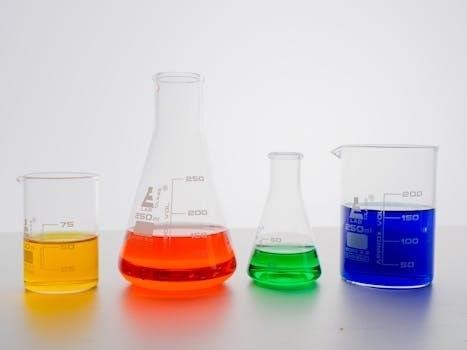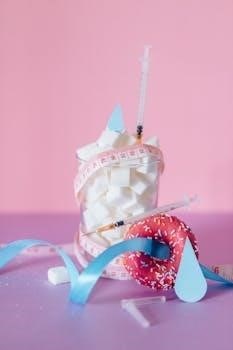Overview of the True Colors Personality Test
The True Colors personality test, inspired by the work of Myers-Briggs, uses colors to represent different personality styles․ It helps individuals identify their core personality traits, categorized into Gold, Blue, Orange, and Green, to foster self-awareness․
Origin and Development of the True Colors Model
The True Colors model has roots in the work of personality theorists like Isabel Briggs Myers, Katherine Briggs, and David Keirsey․ Don Lowry, a student of Keirsey, significantly developed the system, creating the True Colors methodology as we know it today․ Lowry’s work simplified complex personality theories into an accessible, color-coded system․
The model aims to help individuals understand themselves and others better by identifying their primary personality style, represented by a specific color․ It moves away from rigid personality types, acknowledging that individuals are a unique blend of all four colors, with one or two being dominant․ This approach encourages self-discovery and improved communication․
True Colors has become a popular tool in various settings due to its simplicity and effectiveness in promoting teamwork, understanding diverse perspectives, and enhancing personal growth․ It is used widely in education, corporate training, and personal development workshops․
The Four Color Personalities⁚ Gold, Blue, Orange, Green
The True Colors model identifies four distinct personality types, each associated with a color․ Golds are responsible, organized, and value tradition․ They thrive on structure and are dependable․ Blues are empathetic, caring, and seek meaningful connections․ They value harmony and authenticity in relationships․
Oranges are energetic, spontaneous, and thrive on excitement․ They are resourceful and enjoy taking risks․ Greens are analytical, knowledgeable, and value competence․ They are independent thinkers who seek understanding and innovation․
Understanding these color personalities allows individuals to appreciate different perspectives and communication styles․ Recognizing these preferences can significantly improve teamwork, reduce conflicts, and foster a more inclusive environment․ Each color brings unique strengths and characteristics to personal and professional interactions, contributing to a well-rounded and effective team dynamic․

Understanding the True Colors Test
The True Colors test assesses personality traits using a questionnaire․ Participants rank word clusters, revealing their dominant color․ This identifies preferences and behaviors, promoting self-awareness and improved interpersonal understanding․
How the True Colors Test Works⁚ Questionnaire and Scoring
The True Colors test employs a self-assessment questionnaire designed to identify an individual’s primary personality type․ The questionnaire presents participants with various sets of descriptive words or phrases, grouped into four categories, each representing one of the True Colors⁚ Gold, Blue, Orange, and Green․
Test-takers are instructed to rank the options within each set from most to least like them, assigning a numerical value (typically 4 to 1) to each choice․ This ranking process forces individuals to prioritize their preferences and identify the traits that resonate most strongly with their self-perception․
Once the questionnaire is completed, the scoring involves summing the numerical values assigned to each color category․ The color with the highest total score indicates the individual’s dominant or primary True Color․ The other scores reveal the relative influence of the remaining colors, providing a more nuanced understanding of their personality blend․
This scoring methodology allows for a quick and straightforward determination of an individual’s True Colors profile, making it an accessible tool for self-discovery and team-building activities․
Interpreting Your True Colors Results⁚ Primary and Secondary Colors
Understanding your True Colors results involves identifying both your primary and secondary colors․ Your primary color, the one with the highest score, represents your dominant personality style, influencing your behaviors, motivations, and values․ It provides a core understanding of how you approach the world and interact with others․
However, individuals are rarely defined by a single color․ Your secondary colors, the colors with the next highest scores, add depth and complexity to your personality profile․ These secondary influences can moderate or complement your primary color, resulting in a unique blend of traits․
For instance, someone with a primary Blue and a secondary Gold may exhibit a strong sense of empathy and creativity (Blue) tempered with a desire for structure and organization (Gold)․ Recognizing these secondary influences allows for a more comprehensive understanding of your strengths and potential areas for growth․
By examining the interplay between your primary and secondary colors, you can gain valuable insights into your communication style, decision-making processes, and overall approach to life․

Applications of the True Colors Model
The True Colors model has various applications, including team building, communication enhancement, and education․ It provides a framework for understanding diverse personalities, promoting collaboration, and improving interpersonal relationships in multiple contexts․
True Colors in Team Building and Communication
True Colors plays a significant role in team building by fostering understanding and appreciation of diverse personality styles․ Recognizing each team member’s dominant color helps tailor communication strategies for improved collaboration and reduced conflict․ For instance, Golds appreciate structure, Blues value empathy, Oranges thrive on spontaneity, and Greens seek logical reasoning․
Effective team dynamics emerge from leveraging the strengths of each color․ Golds ensure organization, Blues promote harmony, Oranges bring creativity, and Greens offer analytical insights․ Understanding these preferences allows teams to assign roles and responsibilities that align with individual strengths, enhancing overall productivity․
Furthermore, True Colors aids in conflict resolution by providing a framework for understanding different perspectives․ When disagreements arise, recognizing the underlying color-based motivations can lead to more empathetic and constructive dialogue․ By acknowledging and respecting these differences, teams can build stronger relationships and achieve common goals more effectively․
True Colors in Education and Learning Styles
True Colors offers valuable insights into diverse learning styles, enabling educators to tailor their teaching methods for optimal student engagement․ Golds thrive in structured environments with clear expectations, Blues learn best through collaboration and emotional connection, Oranges excel in hands-on activities that encourage creativity, and Greens prefer independent study with a focus on logic and reasoning․
By recognizing these preferences, educators can create a more inclusive and effective learning environment․ Incorporating varied teaching strategies that cater to each color type ensures that all students have the opportunity to succeed․ For example, Golds benefit from organized lesson plans, Blues appreciate group projects, Oranges enjoy interactive simulations, and Greens excel with research-based assignments․
Moreover, True Colors helps students understand their own learning styles, empowering them to take ownership of their education․ Self-awareness allows students to advocate for their needs and develop strategies that enhance their learning experience, ultimately leading to improved academic performance and a greater appreciation for lifelong learning․

Accessing and Using the True Colors Test PDF
Accessing a True Colors test PDF online requires caution․ Look for reputable sources to ensure the validity of the test․ Using a free PDF can provide insights, but consider its limitations for comprehensive results․
Finding a Reliable True Colors Test PDF Online
Finding a reliable True Colors test PDF online requires careful consideration․ Due to varying sources, it’s crucial to prioritize credibility․ Begin by searching reputable websites associated with psychology, education, or organizational development․ Look for sites affiliated with established institutions or certified True Colors facilitators․
Check for reviews or testimonials regarding the accuracy and validity of the PDF test․ A trustworthy PDF should clearly outline the test’s methodology, referencing the original True Colors model developed by Don Lowry and based on the work of researchers Isabel Briggs-Myers, Katherine Briggs, and David Keirsey․
Beware of websites offering overly simplistic or generic versions, as these may not provide accurate insights․ A reliable PDF will include clear instructions for completing the questionnaire and interpreting the results, emphasizing that the True Colors assessment is a tool for self-awareness and understanding, not a definitive label․
Ensure the PDF is free from copyright infringements and respects intellectual property rights․ Prioritize PDFs that offer additional resources, such as explanations of each color’s characteristics and guidance on applying the True Colors model in various contexts․
Considerations When Using a Free True Colors Test PDF
When utilizing a free True Colors test PDF, several considerations are crucial for accurate interpretation․ Primarily, understand that free versions may be simplified and lack the depth of professionally administered assessments․ They serve as introductory tools, offering a general understanding of the True Colors model rather than a definitive personality analysis․
Ensure the PDF includes clear instructions and scoring guidelines․ Pay close attention to how the questionnaire is structured and how the results are calculated․ Be wary of PDFs that are poorly formatted or contain ambiguous language, as these can lead to misinterpretations․
Remember that self-assessment tools are subjective․ Your responses reflect your self-perception, which may differ from how others perceive you․ Consider seeking feedback from trusted colleagues or friends to gain a more balanced perspective․
Recognize the limitations of the True Colors model itself․ While it provides a framework for understanding personality preferences, it doesn’t encompass the full complexity of human behavior․ Avoid using the results to stereotype individuals or make generalizations․
Finally, be aware of potential biases in free online resources․ The PDF may be designed to promote a particular product or service․ Approach the results with a critical mindset, and use them as a starting point for further self-exploration․

Comparison with Other Personality Assessments
The True Colors assessment, unlike others, utilizes colors for personality identification․ It differs from tools like Myers-Briggs, offering a simpler framework․ True Colors focuses on broader styles, not detailed types, for easier understanding and application․
True Colors vs․ Myers-Briggs Type Indicator (MBTI)
True Colors and the Myers-Briggs Type Indicator (MBTI) are both personality assessments, but they differ significantly in scope and complexity․ True Colors simplifies personality into four color-coded styles⁚ Gold, Blue, Orange, and Green․ This model emphasizes understanding core values and communication preferences associated with each color․
In contrast, MBTI identifies 16 distinct personality types based on four dichotomies⁚ Extraversion vs․ Introversion, Sensing vs․ Intuition, Thinking vs․ Feeling, and Judging vs․ Perceiving․ MBTI provides a more detailed analysis of cognitive functions and behavioral patterns․
While MBTI requires a certified practitioner for proper interpretation, True Colors is generally easier to understand and apply in team-building and educational settings․ True Colors focuses on improving interpersonal relationships by highlighting individual differences․ MBTI offers a deeper dive into personality, suitable for career counseling and personal development․
Ultimately, the choice between True Colors and MBTI depends on the desired level of detail and the intended application․

